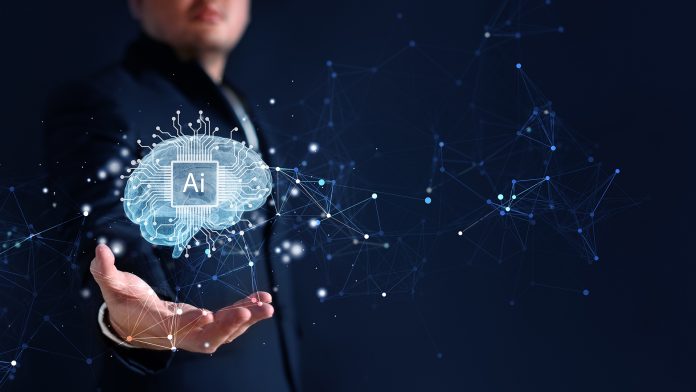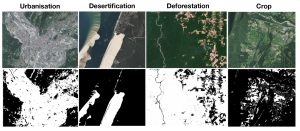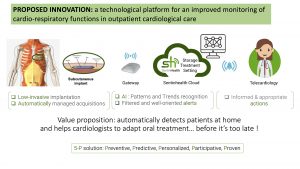MIAI1 develops the next generation of Artificial Intelligence models and systems, from hardware and embedded architectures to software.
Artificial Intelligence (AI) decision systems are currently deployed on a large scale and are already affecting our everyday lives. These systems raise many scientific challenges in terms of the mathematical foundations they rely on, their security, robustness, privacy, fairness, and data efficiency when mass annotated data are not available. They also require interaction abilities, which implies solving problems such as perceiving, analysing, and learning the information structure of a given environment and processing it correctly and efficiently.
AI must also move out of the cloud to meet its users and overcome the problems of communication overload and data privacy. Hardware architectures for AI are also a key topic for new applications, embedded in low-power, low-latency devices.
In addition, AI offers a lot of possibilities to develop innovative solutions that impact many domains. For instance, with AI, smart health opens many opportunities to realise the promises of the predictive, preventive, personalised, participatory (P4) vision of medicine.
AI can also be useful in addressing environmental issues by helping to monitor biodiversity and air and water quality, predict natural hazards, and develop new technologies for smart grids to reduce energy consumption. It also paves the way to new manufacturing processes and helps develop industrial strategies as ‘servitisation’ and circular economy.
But AI also raises many questions, for example regarding ethical and legal regulations, its perception by society, and its environmental impact.
With more than 90 private partners, with a team of around 250 permanent academic members, 160 PhD students and 55 postdoctoral researchers, MIAI addresses all these challenges and makes fundamental and applied contributions in all these areas through strong interdisciplinary collaborations.
MIAI brings together experts in various domains such as: Computer science, mathematics, physics, geology, biology, medicine, ecology, sociology, law or philosophy. This core team of researchers and engineers works in close collaboration with structures and experts of innovation, technology transfer and start-up creation.
Together, all these actors make MIAI’s R&D ecosystem particularly rich and dynamic: 41 chairs, 150 collaborative projects and 32 exploratory projects were created and funded; more than a thousand scientific publications and 30 patents were issued; several members of MIAI were awarded prestigious grants and prizes or nominated to prestigious institutions; ten start-ups were created and ten more are in the process of being created.
Research at MIAI
The research objectives we are pursuing are two-fold. First, we aim to study current AI models and related hardware/software systems so as to better understand them and propose their next generation.
This objective, which we call Next Stage AI, implies, on the theoretical front, to better understand the mathematical foundations of AI, using tools from optimisation, large-dimensional statistics and game theory, and propose new models which are theoretically sound, data efficient and do not suffer from catastrophic forgetting.
On a more applied front, we aim to endow AI systems with enhanced visual abilities, enhanced natural language and speech processing abilities, as well as enhanced collaborative and control abilities.
Lastly, as hardware architectures are central to the development of AI systems, we aim, on the material front, to accelerate existing architectures and propose new ones. Our second objective fits under the programme AI for Human Beings and the Environment. This aims to study: The integration of AI into society; the possible ethical and legal regulations of AI by society; how AI can help achieve the four P4 objectives.2; how it can help monitor our environment and preserve it; and how it can help build the industry of the future.
Among the many contributions MIAI has had since 2019, one can cite:
- Our action on AI regulation where we showed how the General Data Protection Regulation and other rules apply to facial recognition, highlighted the legal gaps to be covered by the AI Act.3 Our work on addressing the question ‘can generative AI survive the GDPR?’ is an example of similar work on generative AI;
- Our recent project integrating in cubesats approximations of convolutional networks which can both be trained and applied online to recognise different zones on the Earth surface (urbanisation, desertification, deforestation, crop); this project, the results of which have been validated on the Qormino space qualified processor of Teledyne e2V, is in the top ten selected projects of the Orbit AI challenge launched by the European Space Agency;3
- In the area of hardware architectures and embedded AI, we have shown that hybrid ANN-SNN (artificial neural networks-spiked neural networks) architectures, leveraging a SNN event-based approach in layers with high sparsity and ANN parallel processing for the others, are a promising new path for further energy savings;5
- MIAI have also shown that self-supervised vision transformer features contain explicit information about the semantic segmentation of an image, which does neither emerge as clearly with supervised vision transformers, nor with convolutional networks;6 and
- In the field of AI for material science, we have provided the first practical proof of the effectiveness of AI methods for adaptive metallurgy, which was made possible by the vast amount of data collected through the Grenoble synchrotron.7
Focus on AI and health
As MIAI is at the service of humans and the environment, we want to further illustrate our actions through a short description of the four original chairs we developed at the crossroad of AI and medicine.
Putting AI at the service of ‘care’ in an integrative health logic is the challenge of the Deep Care: Patient Empowerment via a Participatory Health Project chair. Headed by Public Health Professor, Philippe Cinquin, it applies Grenoble’s expertise in capturing real-life data, from individual to environmental levels. The capture is carried out by micro and nanosensors that enable patients to be the actors of their own health.
Four tasks have been defined. The first task aims to capture relevant data through various means. For example, electric bicycles and smart waistcoats to adapt a rehabilitation programme, sensors to characterise cardiac effort, swallowable micro-robots with biological programming to analyse the microbiota with a view to diagnosing a chronic disease with the start-up Pelican, or an implantable medical device to analyse physiological variations in order to prevent a relapse of heart failure with the start-up SentinHealth.
The second task is to merge massive and heterogeneous data thanks to PREDIMED, a health data warehouse designed at the Grenoble Alpes University Hospital, which makes it possible to identify health determinants that can improve patient care.
The third task consists of correlating hospital data and human and social sciences (SHS) to propose a reorganisation of the emergency service of the Grenoble Alpes University Hospital, which has been weakened by the implementation of the T2A (fee-for-service).
The fourth, more transverse task, concerns the SHS: Self-image and body anthropology are at the heart of tools co-constructed with patient associations. The Chair also collaborates with the MSA (agricultural social security identification of new correlations between long-term illnesses and occupations), Thales (image processing for better management of undernutrition), ICAlps and ST Microelectronics (design of miniaturised intelligent implantable devices), as well as several start-ups (Etisense, Texisense, eBike- Labs, Theia) and other industrial partners.
Co-directed by Jocelyne Troccaz, CNRS research director, and Sandrine Voros, CNRS research fellow, the Computer-Assisted Medical Interventions (CAMI) Assistant chair aims to develop a new generation of computerised intraoperative assistants based on AI, with the aim of treating patients more efficiently and less invasively. The fusion of Big Data, coupled with simulation and monitoring tools, could improve surgical strategy decisions and the quality of surgical procedures.
Deep Learning and Machine Learning are used to solve problems of medical image segmentation, to sort out relevant information from non-useable data or to better understand surgeons’ movements and to empower certain parts of the procedure where human added value is not essential. For example, in laparoscopic surgery, a questionnaire submitted to six surgeons recently showed that they tended to agree with the criteria chosen by the algorithms to make their decisions. Ultimately, these new techniques offer a new perspective on old problems.
The Artificial Intelligence for High Throughput Biomedical Investigations chair is headed by Professor Julien Thévenon, head of the genetic medicine department at Grenoble University Hospital, and Dr Thomas Burger, a biostatistics researcher at CNRS. Its scientific programme is composed of two main components. Co-directed by Dr Emmanuel Barbier, Director of Research at Inserm, and Julien Thévenon, the first one focuses on the evaluation of AI applications to rare diseases using medical data, brain imaging data and whole genome sequencing (neuro-genomics). The second one, supervised by Thomas Burger and Bertrand Toussaint, professor of biochemistry at Grenoble University Hospital, is proteomics. Julien Thévenon said: “The objective is to explore the identification of biomarkers using a mass spectrometry approach.”
The chair is funded by Grenoble Alpes University, the ANR and four active industrial partners: The SMEs Pixyl (Grenoble) and SeqOne (Montpellier) as well as the medical biology laboratory Biomnis (Lyon) for neuro-genomics and the SME Sinnovial for proteomics. In addition, neuro-genomics is at the intersection of several national plans: The 2018-2022 Rare Diseases Plan 3, with three reference centres labelled by the Ministry at the Grenoble University Hospital, France Médecine Génomique 2025, which benefits from the AURAGEN (Auvergne Rhône-Alpes Génomique) very high-speed sequencing platform and, of course, the French National Artificial Intelligence Plan.
MyWaytoHealth is chaired by Jean-Louis Pépin, professor of clinical physiology at Grenoble Alpes University, vice-dean of the Grenoble Faculty of Medicine in charge of research and director of the HP2 Laboratory. Its ambition is to use AI to develop a ‘trajectory medicine’ applied to obstructive sleep apnoea (OSA), which affects one billion people worldwide. Innovation is the concept of trajectome, which encompasses the conditions, risk factors, environmental and societal determinants that modulate the trajectory of the disease in the patient’s ecosystem.
The chair relies on AI and the integrative analysis of structured and unstructured data captured by individual digital health passports, international and national disease registries, longitudinal data generated by innovative sensors, national administrative databases on healthcare, socio-economic determinants, attitudes and behaviours.
A rich harvest that will feed three research axes: Large-scale treatment and interactive multidisciplinary exploration of patient trajectories; prediction of health evolution and aggregation of co-morbidities; integrated and patient-centred care; and health system reform and cost-effectiveness evaluation. This will be a valuable contribution to rethinking clinical decision making and therapeutic interventions for value-based reorganisation of care.
Creating an international reference for interactive AI systems
In the coming years, we want to create an international reference for embedded, interactive generative AI systems which are frugal & trustworthy by design and beneficial to humans and the environment.
MIAI will continue to develop AI systems in health, environment and energy and industry, and will address new application areas as AI in education, quantum, and cultural and creative industries, as illustrated above.
References
- https://miai.univ-grenoble-alpes.fr/
- Predictive, preventive, personalized and participatory.
- https://ai-regulation.com/author/theodore-christakis/
- https://ai4eo.eu/portfolio/orbitalai-challenge/
- I.-E. Benrabah, H.P. Van Landeghem, F. Bonnet, B. Denand, G. Geandier, A. Deschamps. High-throughput investigation of ferrite growth kinetics in graded ternary Fe-C-X alloys, Materialia (24), 2022.
- M. Caron, H. Touvron, I. Misra, H. Jégou, J. Mairal, P. Bojanowski, A. Joulin. Emerging Properties in Self-Supervised Vision Transformers, International Conference on Computer Vision (ICCV), 2021.
- M. Dampfhoffer, T. Mesquida, A. Valentian, L. Anghel. Are SNNs really more energy-efficient than ANNs ? An in-depthe hardware-aware study, IEEE Transactions on Emerging Topics in Computational Intelligence, 2022.
Please note, this article will also appear in the sixteenth edition of our quarterly publication.












